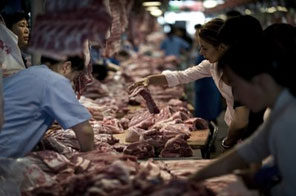China becomes last nation to lift ban on US pork
DES MOINES: Nearly a year after nations banned U.S. pork over fears about swine flu, China has become the last one to lift its embargo and is expected to accept shipments by early next month.
It's a move welcomed by an industry that has suffered several years of losses, but some experts caution farmers shouldn't expect to see a surge in exports. China still produces most of the pork it consumes and won't accept pork containing ractopamin, an additive used in the U.S. that causes hogs to turn feed to muscle instead of fat.
Still, lifting of the ban is good news for U.S. pork farmers, who were hit with a triple whammy of high feed costs, a drop in demand at home with the recession and import bans by more than two dozen countries worried about transmission of swine flu, also known as H1N1.
"Our producers have been losing money since 2007 ... and the fact that China is open is very important," said Nick Giordano, vice president and counsel for international affairs for the Washington D.C.-based National Pork Producers Council.
China agreed to lift the ban last week during a visit by U.S. trade representatives, Giordano said. Some minor details were being worked out this week, and Giordano said he expected pork shipments to China to resume within two weeks.
Russia, another major market for U.S. pork, lifted its ban tied to swine flu last fall but continued to refuse U.S. pork because of unrelated — and farmers believe unmerited — concerns about food safety, Giordano said. Russia's concerns are being met with a special testing program and shipments could resume soon, he said.
Pork to be sent to Russia is tested at processing plants for the antibiotic tetracycline and pathogens.
Before the bans, about 20 percent of U.S. pork was exported, and China and Russia were among the biggest buyers. In 2008, China bought nearly $700 million in U.S. pork, ranking third behind Japan and Mexico. Russia was fifth with $476 million.
Still, Iowa State University livestock economist Shane Ellis said resuming exports to those countries would probably boost sales only a bit. Exports to China were already beginning to drop off in late 2008, well before the swine flu controversy, Ellis said.
"In 2008, they were reaching out because pork was cheap, they were having earthquakes and diseases that were affecting their hogs and they had the Olympics and they wanted to have quality meat products for the extra crowds," he said. "They got in big and as we hit August and after the Olympics, it flat-lined and they just weren't buying."
China, the world's largest producer and consumer of pork, doesn't like to depend on imports, Ellis said.
"They have policies to shore up their own pork production and to say they are all of a sudden going to quit producing pork, it's not going to happen," he said.
Of course, any additional exports will help U.S. producers, Ellis said. He estimated total exports will rebound this year to about the level in 2008, when China accounted for about 6 percent of U.S. pork exports.
Chuck Wirtz, a hog farmer from north-central Iowa, said he doesn't expect the reopened Chinese market to make a big difference to his business. Despite China's ban, U.S. pork was still making it into the country through Hong Kong, which continued to buy U.S. pork, he said.
"It's not a negative thing," Wirtz said. "I just don't see it impacting things like some people do."
Iowa is by far the nation's biggest hog producer, raising almost twice as many as second-ranked North Carolina.
The reopening of foreign markets comes as the market for pork is rebounding. The U.S. economy is sputtering back to life, and Americans are less concerned about catching swine flu from pork, a fear health officials have said was groundless because the nation's hogs were not to blame for the epidemic.
After losses of $20 or more per head in 2009, Ellis said farmers could see profits of at least $10 a head this spring.
Consumer prices aren't likely to increase, however, he said. The price meat processors pay farmers is only a small fraction of the cost of producing pork.
One issue that remains to be resolved is China's continued ban on pork containing commonly used ractopamin, Giordano said. But even so, the U.S. produces enough additive-free pork to potentially ship $700 million worth to China this year.
"I can't tell you how the markets have or will react to this," Giordano said, "but it is significant."






